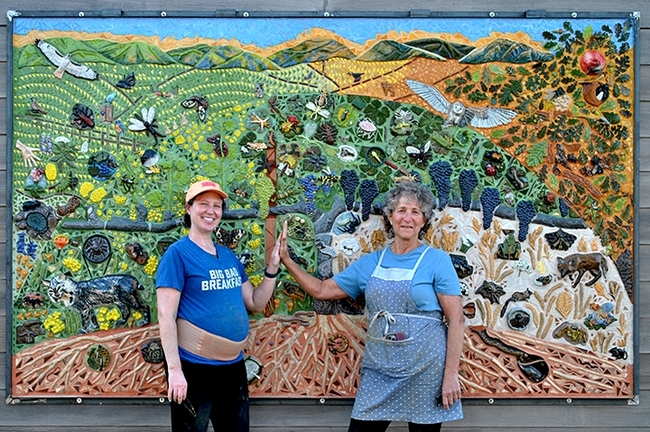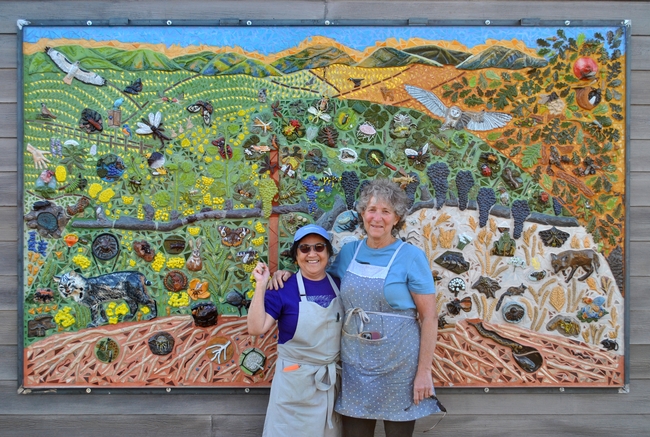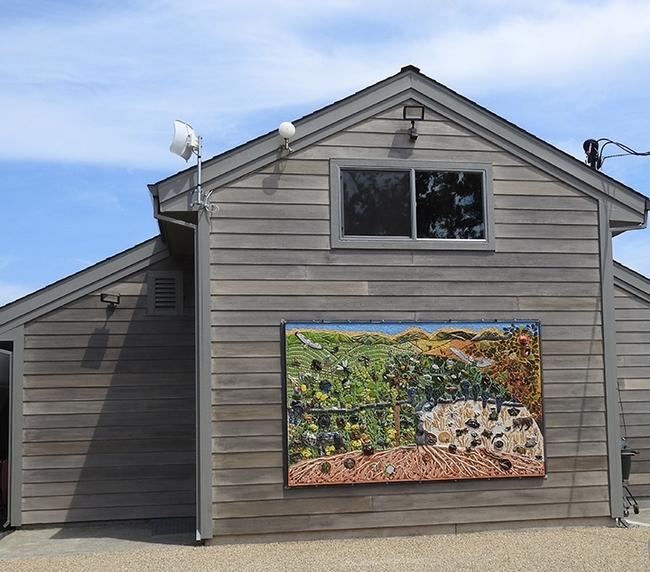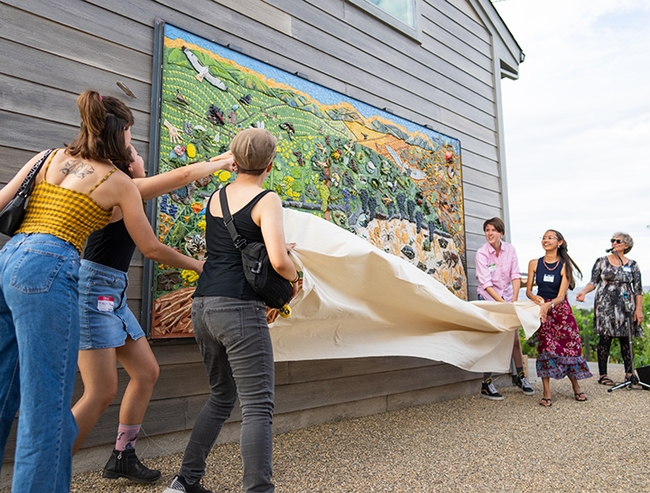- Author: Kathy Keatley Garvey
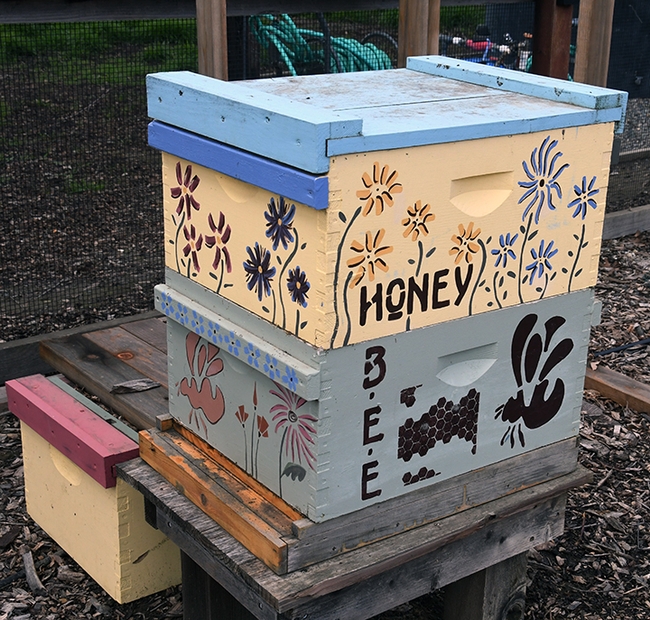
No, wait. Catch...examine...and then release.
That's what attendees will do at the UC Davis Bee Haven's 15th anniversary celebration, set from 10 a.m. to noon on Saturday, April 6 on Bee Biology Road, west of the central campus.
They'll be using a bee vacuum device to scoop up a honey bee, carpenter bee, bumble bee or other pollinator for close observation.
The half-acre garden is located next to the Harry H. Laidlaw Jr. Honey Research Facility. Both are part of the UC Davis Department of Entomology and Nematology.
The open house, free and family friendly, will include a tour of the garden at 11 a.m.; catch-and-release bee activity to observe bees up close; information about low-water plants; and presentations on University of California pollinator research.
The haven is open daily from dawn to dusk (no admission). It is described as "a unique outdoor museum that provides resources for local bee pollinators, inspires and educates visitors to create pollinator habitat gardens, and provides a site for the observation and study of bees and the plants that support them."
Director of the garden is Elina Lastro Niño, associate professor of Cooperative Extension - Apiculture, UC Davis Department of Entomology and Nematology. Christine Casey is the manager, the academic program management officer.
Workers installed the garden in the fall of 2009, under the tenure of interim department chair Lynn Kimsey, now UC Davis distinguished professor emerita, and with primary funds from the Häagen-Dazs ice cream brand. Featuring a series of interconnected gardens with names like “Honeycomb Hideout,” “Nectar Nook” and “Pollinator Patch,” it was designed to provide the Laidlaw honey bees with a year-around food source, raise public awareness about the plight of honey bees, encourage visitors to plant bee-friendly gardens of their own, and serve as a research site.
A six-foot worker bee sculpture of ceramic and mosaic anchors the garden. It's the work of self-described "rock artist" Donna Billick of Davis. UC Davis distinguished professor Diane Ullman and Billick co-founded and directed the UC Davis Art-Science Fusion Program, and their art and that of Ullman's entomology students, as well as members of the community and other volunteers, are showcased throughout the garden.
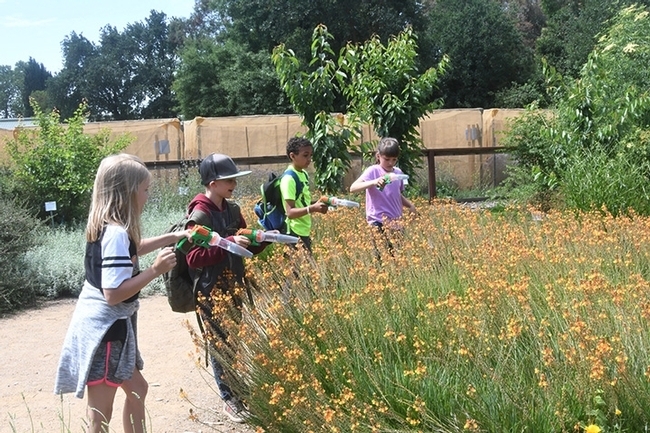
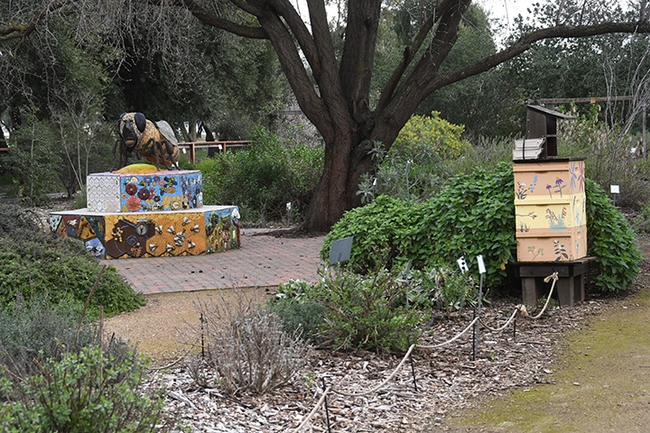
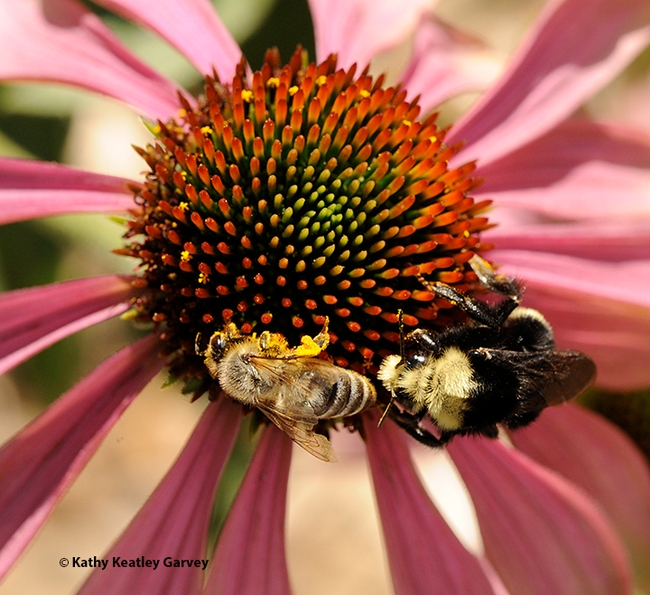
- Author: Kathy Keatley Garvey
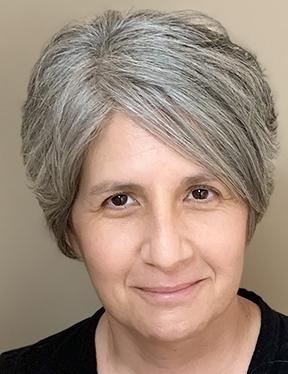
Fifty-seven scientists from five continents, including UC Davis distinguished professor-entomologist Diane Ullman, co-authored the article, “Genome-Enabled Insights into the Biology of Thrips as Crop Pests,” published in the journal BMC Biology.
The project leader and first author? Ullman's longtime colleague and collaborator, Professor Dorith Rotenberg of the Department of Entomology and Plant Pathology at North Carolina State University (NCSU). (See news story)
Fast forward to next week, when Professor Rotenberg will present a seminar sponsored by the UC Davis Department of Entomology and Nematology on “Advances and Innovations in the Characterization of Molecular Interactions Between Frankliniella occidentalis and Tomato Spotted Wilt Virus.”
Her seminar, with Ullman introducing her, begins at 4:10 p.m., Monday, Feb. 26 in 122 Briggs Hall. It also will be on Zoom. The Zoom link:
https://ucdavis.zoom.us/j/95882849672.
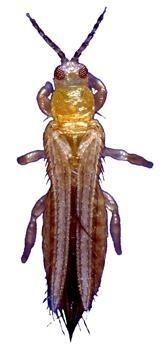
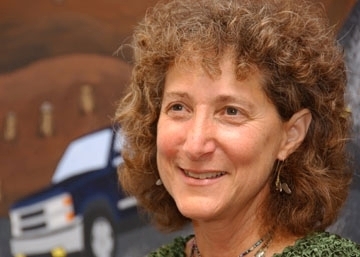
Rotenberg holds three degrees from the University of Wisconsin-Madison: a bachelor of science degree in biochemistry and her master's and doctorate in plant pathology.
The western flower thrips, native to Western North America, causes billions of dollars a year in damage worldwide. About the size of a pinhead, the insect feeds on a wide array of food, fiber, and ornamental crops and transmits plant viruses that cause significant economic damage.
“The western flower thrips and the viruses it transmits, including tomato spotted wilt virus, is important to California agriculture, causing serious problems for tomato growers, pepper growers and growers of leafy greens,” Ullman says. The tomato spotted wilt virus infects more than 1000 plant species, ranging from tomatoes, tobacco and peanuts to pansies and chrysanthemums. (See Ullman's work on her website)
For Zoom technical issues, contact seminar coordinator Brian Johnson, associate professor, at brnjohnson@ucdavis.edu. The list of department seminars for the winter quarter is here.
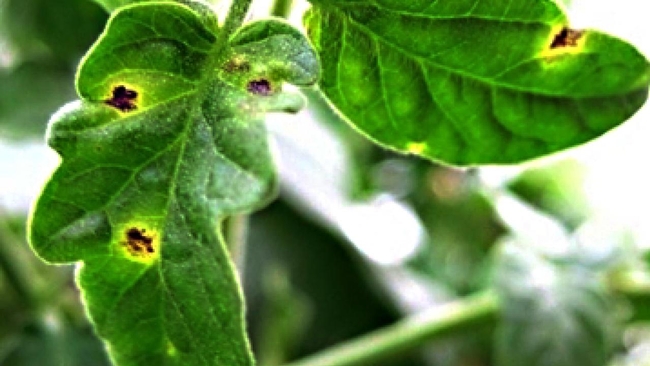
- Author: Kathy Keatley Garvey
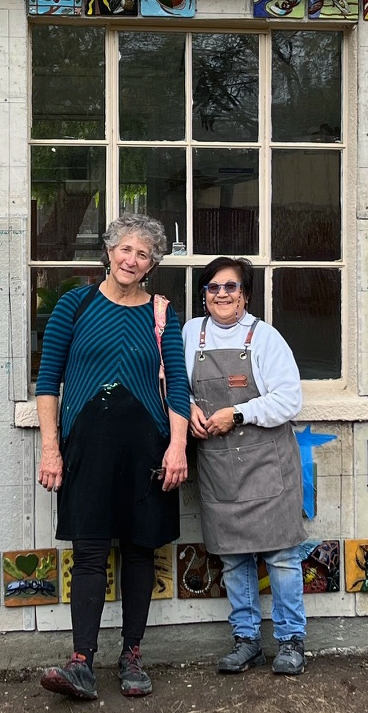
News flash: This year, at the 13th annual Biodiversity Museum Day, set Saturday, Feb. 10, visitors are bound to marvel at "A Bird's Eye View."
It's an epic large-scale ceramic-mosaic of raptors (and insects) that's newly installed on an outside wall of the visitors' center. It pays tribute to "the interactions between insects and birds," said UC Davis distinguished professor Diane Ullman, an internationally recognized entomologist and artist with the UC Davis Department of Entomology and Nematology.
It's primarily the work of UC Davis students in the Entomology 001 course, "Art, Science and the World of Insects," a general education class taught by Ullman and supported by the department.
Ullman and Gale Okumura, a visual communicator and a retired faculty member in the UC Davis Department of Design, led the project and created pieces, as did others from UC Davis and members of the community.
Ullman describes "A Bird's Eye View" as "an epic large-scale mural, 8-feet tall and 22-feet wide, made of more than 1300 handmade ceramic relief artworks, tiles and trim pieces."
"The mural celebrates 11 key raptor species found in California and 84 insect species that are either parasites of these raptors or eaten by them," Ullman said.
More information--illustrated with photos--will be posted next week on the UC Davis Entomology and Nematology website (and on Bug Squad blog).
The Raptor Center will be open from 9 a.m. 3 p.m., Feb. 10 during the UC Davis Biodiversity Museum Day. ""Our non-releasable ambassador raptors can be seen on exhibit, and several of our glove-trained ambassador raptors will be out with their handlers throughout the day," said Julie Cotton, co-manager of operations. "Visitors will have the opportunity to see multiple native raptor species up close and talk to our experts. We are happy to answer questions about birds of prey! Our small on-site museum will also be open with taxidermy specimens and interactive raptor-related activities."
Meanwhile, what is the UC Davis Biodiversity Museum Day? It's like a Super Science Day. This year 10 museums and collections will be featured. It's a great opportunity to talk to UC Davis scientists and see their work, and it's free and family friendly.
- Anthropology Museum, 328 Young Hall and grounds, open from noon to 4 p.m.
- Arboretum and Public Garden, Habitat Gardens in the Environmental GATEway, adjacent to the Arboretum Teaching Nursery on Garrod Drive, 10 a.m. to 2 p.m.
- Bohart Museum of Entomology, Room 1124 and main hall of the Academic Surge Building, 455 Crocker Lane, 10 a.m. to 2 p.m.
- Botanical Conservatory, the greenhouses along Kleiber Hall Drive, 10 a.m. to 2 p.m.
- California Raptor Center, 1340 Equine Lane, off Old Davis Road, 9 a.m. to 3 p.m. (Located three miles south of the central campus.)
- Center for Plant Diversity, Katherine Esau Science Hall off Kleiber Hall Drive, 10 a.m. to 2 p.m.
- Nematode Collection (part of the UC Davis Department of Entomology and Nematology), Katherine Esau Science Hall, off Kleiber Hall Drive, 10 am. to 2 p.m.
- Museum of Wildlife and Fish Biology, Room 1394, Academic Surge Building, 455 Crocker Lane, 10 a.m. to 2 p.m.
- Paleontology Collection, Department of Earth and Planetary Sciences, 1309 Earth and Physical Sciences Building, 434 LaRue Road, 10 a.m. to 2 p.m.
- Phaff Yeast Culture Collection, Robert Mondavi Institute Brewery and Food Processing facility, Old Davis Road, 10 a.m. to 2 p.m.
See Biodiversity Museum Day website for more information and to download a map, which shows the locations, where food purchases are available, and free parking lots. The map points out grayed-out parking lots that may require paid parking.
Last year's Biodiversity Museum Day drew some 4000 people, said chair and co-founder Tabatha Yang, education and outreach coordinator for the Bohart of Museum of Entomology. See Biodiversity Museum Day website for more information and to download a map, which shows the locations, where food purchases are available, and free parking lots. The map points out grayed-out parking lots that may require paid parking.
And when you visit the California Raptor Center (part of the UC Davis School of Veterinary Medicine) be sure to see the "Bird's Eye View." Absolutely incredible!
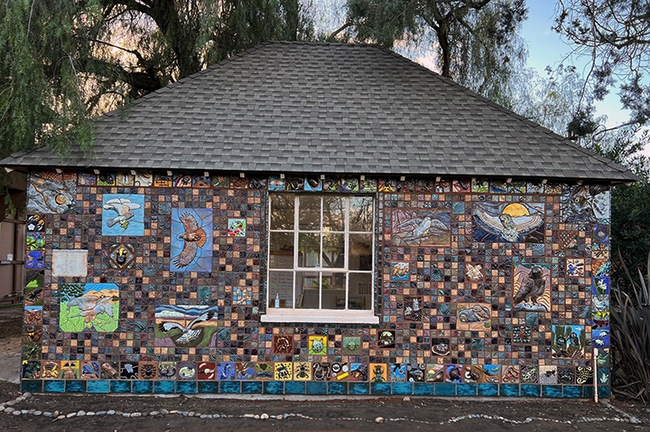
- Author: Kathy Keatley Garvey
It was quite a celebration during the unveiling of a UC Davis ceramic-mosaic mural, The Secret Life of Vineyards, took place at a Napa Valley organic vineyard.
The 10 x 6-foot mural, which graces an outer wall of the Matthiasson Winery on Dry Creek Road, Napa, depicts more than 80 arthropods (insects, spiders and centipedes), several bird species, mammals (bobcat, deer, rabbits, squirrels, a pocket gopher), a gopher snake, mycorrhiza fungi and even earthworms, according to the three project leaders, UC Davis distinguished professor Diane Ullman and assistant professor Emily Meineke, both of the Department of Entomology and Nematology, and retired lecturer Gale Okumura of the Department of Design.
The project is the culmination of a spring quarter class, Entomology 001, “Art, Science and the World of Insects,” taught by Professors Ullman and Meineke. Ullman, founding co-director of the UC Davis Art/Science Fusion Program, described the project as “a collaboration between students and instructors in ENT 001; community members from Davis, Woodland, and Napa, and Matthiasson Winery; and the UC Davis Art/Science Fusion Program." Eighty-three UC Davis students participated in the mural.
UC Davis Chancellor Gary May, Professor Ullman and Steve Matthiasson, owner of the winery, were among those delivering presentations.

Also in his address, Chancellor May discussed how UC Davis "is on the leading edge of innovation in the wine world. One of the first things visitors see as they enter our campus is a 120-acre vineyard that's used for grape breeding programs, rootstock trials and other research." (See news story)
In her presentation, Professor Ullman described the project "a testimony to the power of collaboration, community effort, creativity and collective will. This expressive, beautiful and educational artwork celebrates the synergy created when art meets science, and people observe the world around them with fresh eyes, testing their ideas and transforming those ideas into new concepts and new insights, and then share their epiphanies with others through design and art."
Ullman noted that the general education class, "Art, Science and the World of Insects," was founded in 1996. It's been taught ever year since, "attracting students from every major offered on the UC Davis campus," she said.
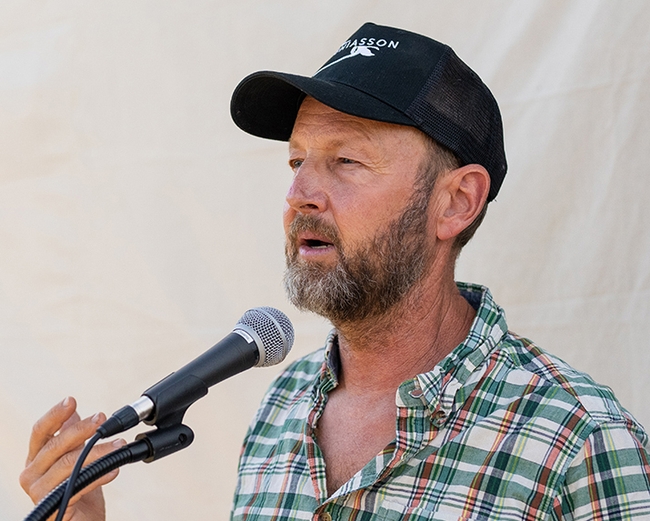
Meineke, an urban landscape entomologist, was unable to attend the Aug. 16th unveiling. Meineke and her husband Joe Kwon just "brought our newest Aggie, Genevieve Se Hwa Kwon into the world," Ullman told the gathering.
In a joint statement, Ullman and Meineke related that The Secret Life of Vineyards was designed to reflect the ecosystem within and around an organic vineyards as it progresses from early spring to harvest. A Cabernet Sauvignon vine is the centerpiece of the mural, shown from the first bud in the spring to harvest time in the autumn...The work is an ode to the importance of biodiversity and balance in the ecosystem in which wine vines are grown and reflects the passion of the Matthiasson Winery for sustainable viticulture.”
The professors credited artist Amanda Larson of Half Moon Bay "with the engineering and building of the hanging system, as well as the installation."
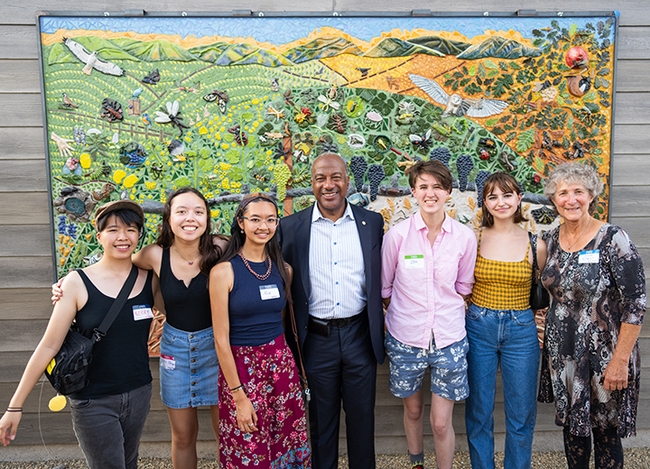
- Author: Kathy Keatley Garvey
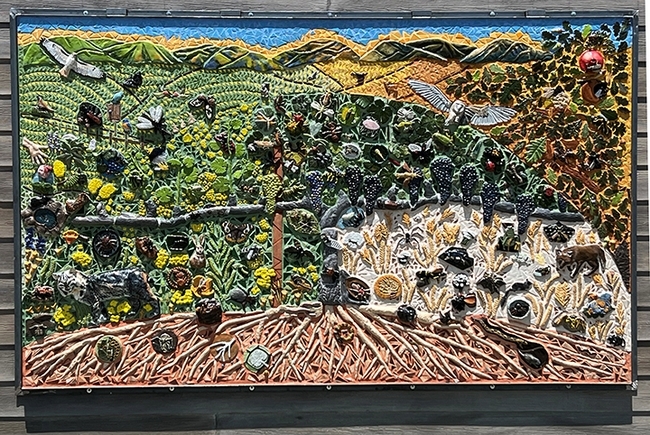
A UC Davis team created the insect-themed ceramic-mosaic mural that was recently installed at the Matthiasson Winery, 3175 Dry Creek Road, Napa.
Measuring 10 feet wide by six feet in height, it will be unveiled at an invitation-only celebration on Wednesday, Aug. 16. That's when “creators, artists, students, and volunteers will see the results of their hard, fun, and educational work creating the incredibly detailed tile mosaic mural depicting The Secret Life of Vineyards,” announced Jesse Galvan, director of hospitality for Matthiasson Wines.
The project sprang to life in a spring quarter class, Entomology 001, “Art, Science and the World of Insects,” taught by two UC Davis entomologists/artists: UC Davis Distinguished Professor Diane Ullman and assistant professor Meineke, an urban landscape entomologist.
Ullman, founding co-director of the UC Davis Art/Science Fusion Program, described the project as “a collaboration between students and instructors in ENT 001; community members from Davis, Woodland, and Napa, and Matthiasson Winery; and the UC Davis Art/Science Fusion Program. Gale Okumura (retired lecturer, UC Davis Department of Design) greatly assisted with the design and also helped train students in the ceramics technique for creating their artwork.”
In a joint statement, Ullman and Meineke related that the Secret Life of Vineyards “was designed to reflect the ecosystem within and around an organic vineyards as it progresses from early spring to harvest. A Cabernet Sauvignon vine is the centerpiece of the mural, shown from the first bud in the spring to harvest time in the autumn. The artworks include more than 80 arthropods (insects, spiders and centipedes), several bird species, mammals (bobcat, deer, rabbits, squirrels, a pocket gopher), a gopher snake, mycorrhizal fungi and even earthworms. The work is an ode to the importance of biodiversity and balance in the ecosystem in which wine vines are grown and reflects the passion of the Matthiasson Winery for sustainable viticulture.”
The directors created a PowerPoint detailing the progression of the art work and the artists' descriptions. They include such descriptions as:
Harrison Ford Spider. Nicholas Nguyen a civil engineering major, depicted the Harrison Ford spider, Calponia harrisonfordi, described by arachnologist Norman Platnick of the American Museum of Natural History in 1993. “In real life, the spider is only around 5 millimeters and much of its biology and physiology is unknown, though it's thought to eat other spiders,” Nguyen wrote. “For the design, I incorporated Indiana Jones' hat as an homage to one of Harrison Ford's most well-known roles. The hat is subdued under the roots as if a farmhand accidentally left it there after a break out of the sun or if Indy transformed into the spider of his actor's namesake.”
“C. harrisonfordi is the quintessential example of legacy,” Nguyen added. “The spider legacy of an archaeologist, blade runner, space smuggler and also environmentalist, activist, actor and ultimately hero, Harrison Ford.”
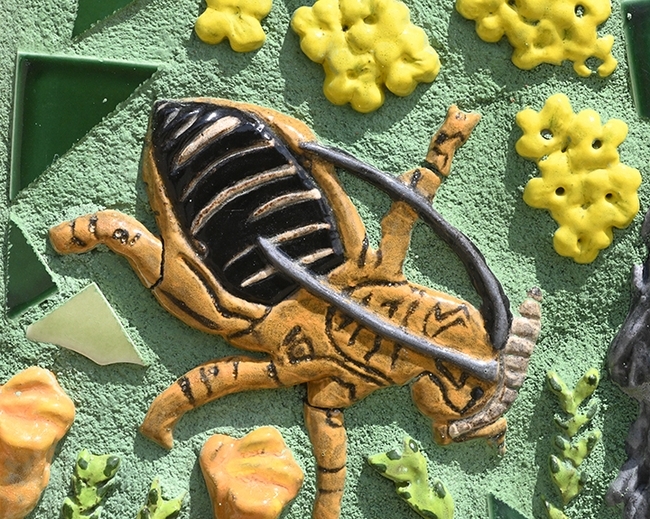
“I wanted to represent the insect scavenging for a waxworm,” Montes related. “I wanted to show that this insect appears aggressive, but also to grant visual diversity within the insect activity throughout the mural. Although many would think that the potato bug is big, clunky, and serves no purpose other than to scare people, researching the insect gave me much more insight on the importance this insect has in the environment, especially in vineyards.”
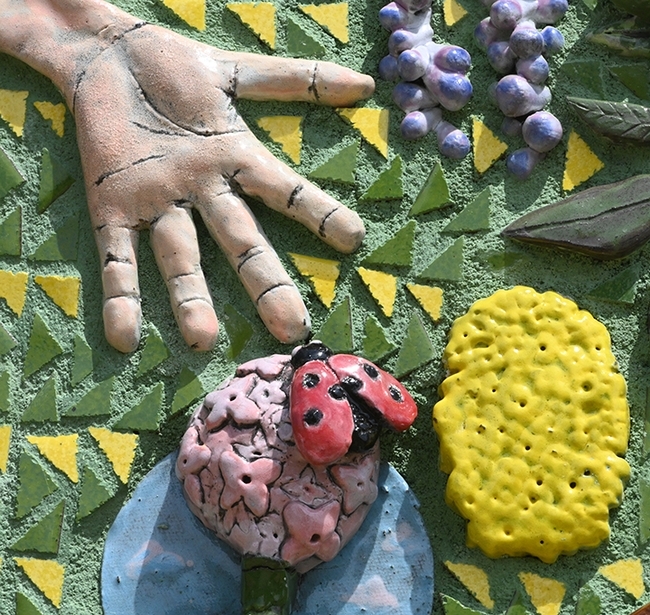
"In my design," Zhou explained, "I aimed to depict the harmonious interaction between C. californica and California buckwheat in wine yield, representing their interdependence and the beauty of their collaboration. The adjacent human is releasing the beetle to the buckwheat, representing the excellent relationship between humans and the California lady beetle. I aim to inspire people to contemplate the profound connections and interdependencies within ecosystems. The collaboration between C. california, humans, and California buckwheat serves as a reminder of the delicate balance and interconnectedness of all living beings. By celebrating the beauty of this symbiotic relationship, we can foster a deeper appreciation for nature's intricate tapestries."
Be sure to access the PowerPoint to read about all the artists' descriptions of their work. And read more about the project here.
